No. 10: Travel
Its many delicious joys, seafood-focused tourism, and kitchen-counter adventures
I’m sure many of you can relate to food looming large in our travels. Which starts with seeking out dining options that showcase the regional cuisine well. And visiting farmers markets is high on the list as well. I always try to hit a market or two, and other food stores along the way, with a radar out for seafood offerings. (And salty snacks, I’m big on sampling regional potato chips.) With seafood, it’s usually just to look, seldom having a kitchen in which to cook the treats. In London, though, at the Old Spitalfields Market I stepped up to an oyster vendor that was shucking on the spot, Maldon oysters slurped down with a local ale to sip alongside. This stop was an aperitif on my way to have lunch at Lyle’s, where a more elegant version of half-shell oysters played out—both versions exquisite.
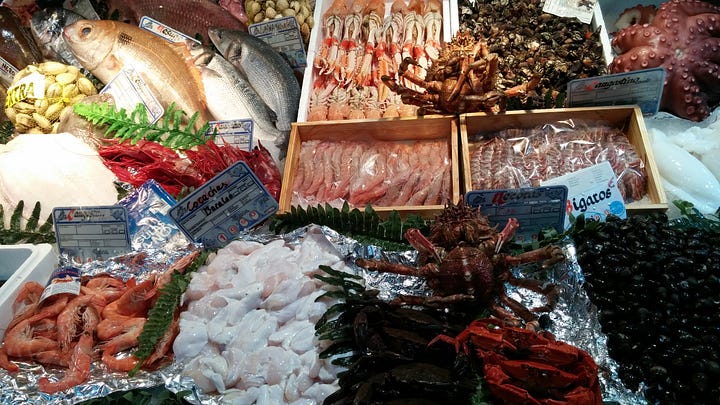
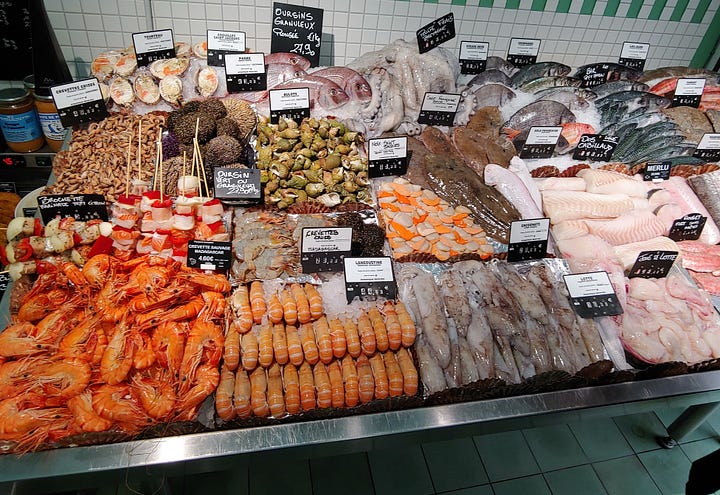
As I began traveling the world years back, it didn’t take long for the connection between travel and food to sink in—seeing, tasting, experiencing things that rarely cross our plates back home. Or more familiar foods may take on new levels of context, our appreciation boosted by experiencing a dish or an ingredient closer to its point of origin, or tasting it in a different setting or preparation, helping broaden our culinary perspectives.
While there are many foods and beverages that can add layers of richness to a trip, I have found that seafood is particularly compelling since it comes in so many different varieties across the globe. Such experiences might include local harvest of a familiar seafood that you get to enjoy in extra-fresh form (such as the South Carolina shrimp we feasted on while on vacation there) or a type of seafood you’d seldom, if ever, see at home (percebes, or gooseneck barnacles, that we had in Lisbon). And sometimes it’s simply seeing familiar seafoods prepared different ways, providing outstanding meals while traveling and inspiration for meals to make once back home. A lunch in A Coruña, Spain, which included mussels en escabeche, is one such example. That dish lodged in my memory and later served as inspiration for a recipe in Oysters.
There are always more travels around the corner, thankfully, more occasions to explore, taste, learn, and continue to expand those memorable seafood experiences.
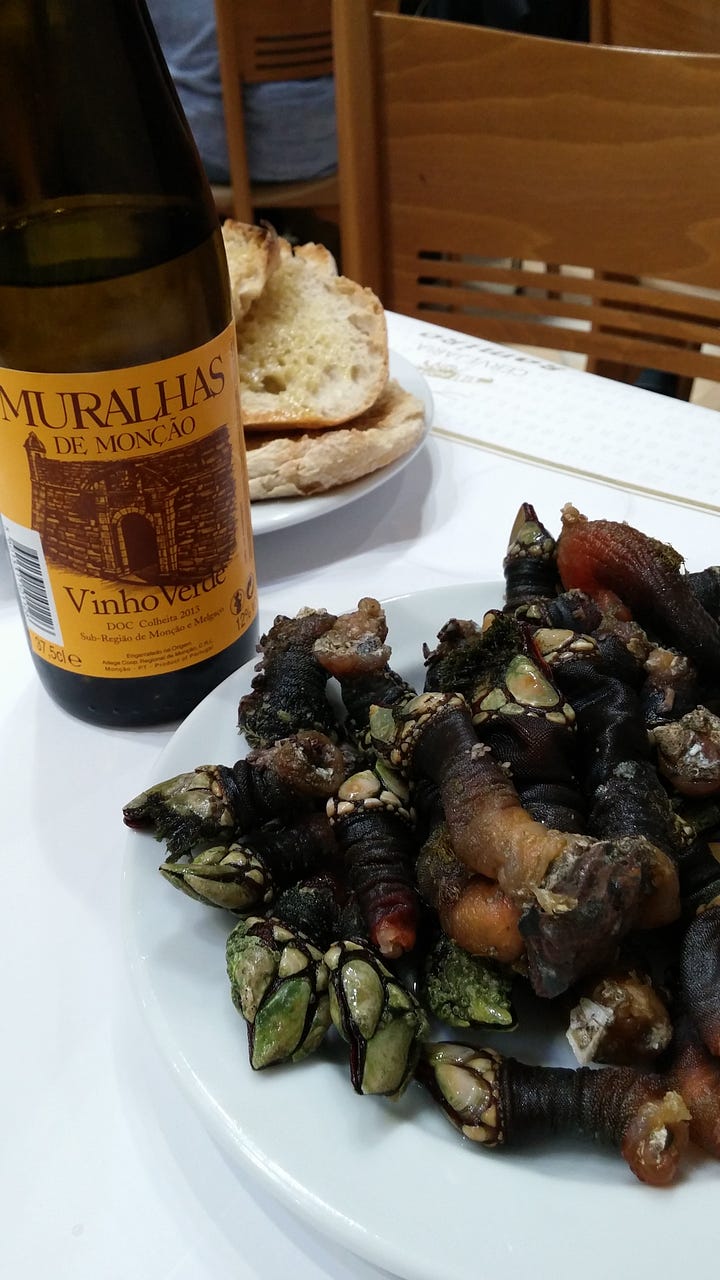
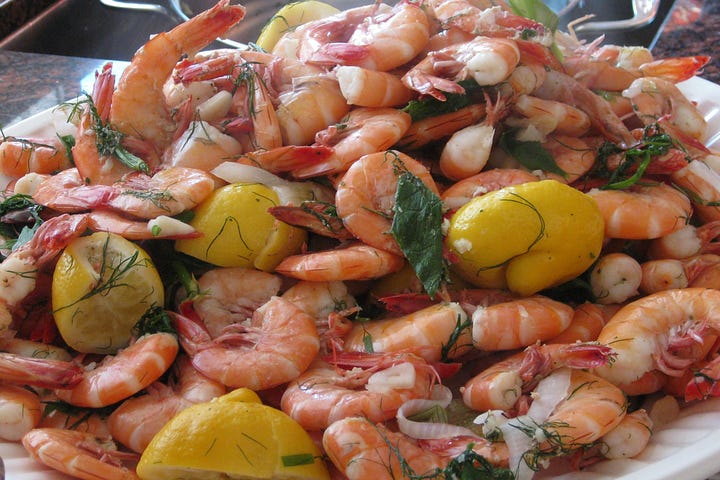
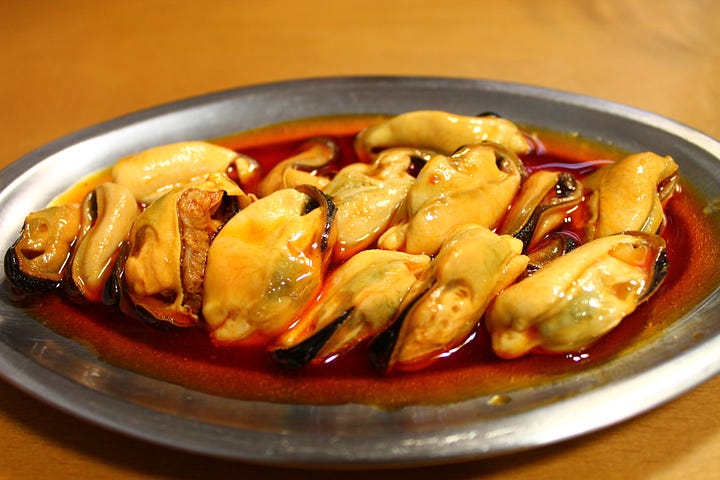
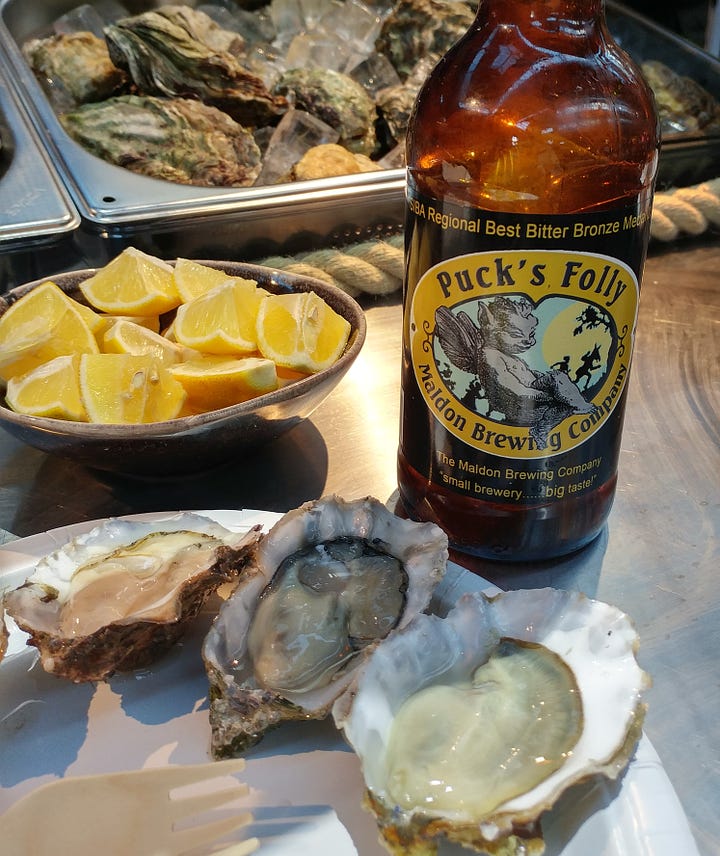
On the Road: Seafood-Centric Travel
I had to agree with my editor that—compared to the core content about buying, storing, and cooking shellfish—my “Perspectives on Place” tidbit was right to trim from my too-long manuscript. I had opportunities elsewhere in the pages to at least touch on the idea of experiencing seafood at its source now and then. Whether it’s a trip that requires a passport, a plane ride, or just hopping in the car for a drive toward the nearest coastline, having seafood on your travel itinerary can be a refreshing, interesting, insightful, and fun way to go. Delicious too, of course, with the chance to taste some of that seafood on the spot.
One part of that content trimmed from the book was a story from a friend. Just as I was finishing up the manuscript, she shared pictures from an impromptu trip she and her husband took in their cool van from northwest Arkansas to South Padre Island at the southern edge of the Texas coast. They hit a couple seafood markets to get local oysters and big brown Gulf shrimp, pulled out the hibachi, and feasted while looking over a beach on the Gulf of Mexico. “The shellfish made that trip!” she told me.
It’s such a perfect example of this notion: now and then, go to where the seafood is. It may take hours of road time but the payoff can be an exquisite meal of supreme simplicity that has a distinct taste of place. And later, back home when you’re cooking seafood, the meal can be enhanced with memories of these adventures.
Among self-guided options for seafoody travel are a number of “oyster trails” around the country such as the Virginia Oyster Trail or the Maine Oyster Trail. Examples I’ve found offer various approaches that in some way or other touch on oyster-focused activities, with varying degrees of educational and gastronomic elements. The trail websites provide such resources as maps, lists of destinations, maybe a trip planner that you can use as you consider using your oyster-loving time well in the region.
A number of oyster farms are open to the public to some degree. You may be able to buy product on site, often within view of the beds where the shellfish are grown. Some farms offer tours, on-site dining—or at least tables at which you can enjoy your just-purchased shellfish, maybe a grill available to cook it. In my neck of the woods, Hama Hama Oysters is a fabulous destination for fans of the bivalve. Located on Hood Canal west of Seattle, they have a farm store where you can buy their shellfish daily. Their Oyster Saloon is open weekends to settle in for some outstanding seafood enjoyed within view of oyster beds. And special events now and then offer even more first-hand experiences on the farm.
Shortly before my oyster cookbook was due eight or so years ago, I decided to take a last-minute field trip down to visit Hog Island Oysters on Tomales Bay in California (as well as oystering my way around San Francisco, including the venerable Swan Oyster Depot of course). It was December, damp and chilly, and absolute perfection for enjoying super-local oysters both raw and grilled.
Oysters do seem to be among the seafoods most frequently featured for these seaside adventures, at least based on what I’ve been finding thus far (and I have been a little oyster-focused in recent years). As my exploration continues I’ll share more about the breadth of options that I come across, including in a newer realm of pescatourism—the sea-going version of agritourism. I gather from some recent reading that Italy is where the idea of pescatourism initially took shape. May need to go do some research.
Retro Seafood: Ocean Liner Dining
I don’t recall when I acquired these menus, they may have been among the many things I brought to my house when we cleared my mom’s apartment after she died. Or maybe she had passed them along to me before that. The thing I’d only recently noticed is that of these menus—all from the S.S. President Cleveland on which we sailed to San Francisco, via Honolulu, from Japan where I was born—only a couple are from dates that we were on board. So my mom clearly sought out other menus from the earlier sailing that month as keepsakes. Which suggests that I have a genetic predisposition to gathering—and keeping—menus of memorable dining experiences.
I was a toddler for that trip and am bummed that I don’t have memories of it. Though there is photographic evidence of me doing the hokey-pokey on board, so I’m pretty sure I had a good time. My brother recalls the ubiquitous midnight buffet and “little food cars delivering petit fours on the main deck for morning and afternoon tea.” Such elegance!
The mere idea of the array of items on these menus, it sets me into a reverie of that era, when trans-oceanic crossings were a practical—if quite posh—means of travel. I have no idea how many times I’ve watched 1957’s An Affair to Remember, but for the sake of this newsletter, I watched it one more time a few days ago. I couldn’t recall if the ship-board scenes evoked much of the culinary offerings for those well-heeled travelers. I can now report that aside from a brief mention of the bouillabaisse being superb (and a guess that some of the silver dishes of indiscernible contents were meant to convey lobster cocktail and the like), the only gastronomic reference of note is the pink Champagne that Terry and Nickie sip together.
Scanning these dinner menus has me dreaming up a dinner party in the spirit of the era (black tie, of course), down to the “table celery” to be served with the splendid array of appetizers: Alaska shrimp cocktail, Portugaise sardines, tomato with anchovy fillet, sliced smoked salmon. Among these few menus at least, fish dishes aren’t too prominent, but I can definitely get behind a dressed-up trout amandine and poached fish with anchovy butter and parslied potatoes. A spread to be rounded out by baby artichokes à la grecque, chilled jellied essence of tomato, Waldorf salad, and chocolate soufflé with vanilla sauce. It sounds divine, simply divine. I think we may skip the Sanka.
Recipe Box: Norwegian-Style Cod with Horseradish
One among many wonderful things about cookbooks is the occasion of virtual travel that many of them offer. I’ve expounded plenty here about the joys of experiencing seafood while out on the road, whether a few states away or across an ocean. But there’s plenty of opportunity to fulfill doses of wanderlust with seafood dishes cooked at home that offer a taste of a place far away.
My friend Darra Goldstein’s book Fire & Ice: Classic Nordic Cooking is a collection of recipes that reflect the ingredients and culinary culture of the Nordic countries. It’s an ideal kitchen-counter-travel cookbook, with personal reflections on time she has spent in the region over the years, essays that offer some context and character from each country, introduction to folks who have enriched her experiences there (including the fishmonger from whom she got this recipe), and plenty of gorgeous, enticing food and location photos.
Although I’ve got a number of pages flagged for cooking to work my way through, this is one I’ve cooked multiple times. Darra said she has only cooked this with cod, as have I, but she mentioned that other firm, relatively mild fish with thick fillets should work, such as hake and halibut. I’ll mix it up with some other fish options next time. I will also note to follow her recipe more closely and cook the fish in a single larger fillet portion instead of individual portions.
One lovely bonus about this recipe is that you’ll surely have extra horseradish on hand after making it. It’s an ideal opportunity to make a quick homemade cocktail sauce for a shrimp cocktail or batch of fried oysters. (Just thinking about fried oysters always makes me want to make fried oysters….)
Norwegian-Style Cod with Horseradish
2 tablespoons butter
2 teaspoons vegetable oil
1 pound cod fillet
1 teaspoon salt
1/2 cup freshly grated horseradish
Heat the butter and oil in a large cast-iron skillet over medium-high heat until the butter begins to brown. Throw down 1/2 teaspoon of salt into the hot pan and immediately place the fish over it. Sprinkle the top of the fish with the remaining 1/2 teaspoon of salt. Cover the skillet (if your skillet does not have a lid, use a lid from another pot or aluminum foil) and cook over medium-high heat until the fish begins to look opaque, about 4 minutes.
Remove the lid, and with a spatula as long as the fillet, carefully flip the fish. Sprinkle the horseradish over the fish and lower the heat to medium. To be sure the fish doesn’t burn, it’s a good idea to check that there is enough fat remaining in the pan; add a bit more butter if necessary. Re-cover the pan and continue to cook 3 to 4 minutes more, until the fish is flaky by still moist. Using the large spatula, carefully transfer the fish to a platter. Serve immediately.
Serves 2 to 4







Seafood is definitely a big deal for us! My first post is about how to gift seafood for travellers coming to Japan. Love reading your work and just thought this was relevant to share.
https://hiddenjapan.substack.com/p/gifts-for-friends-food-based-pt1